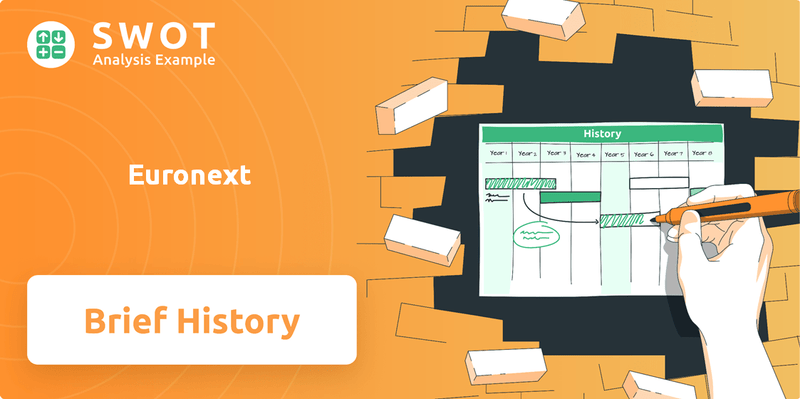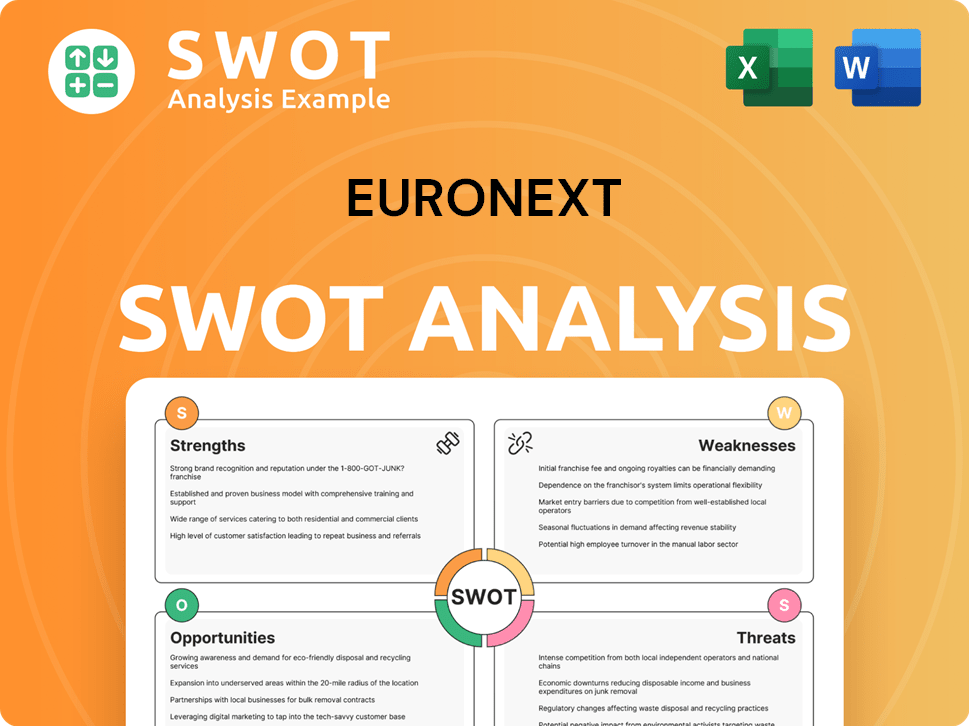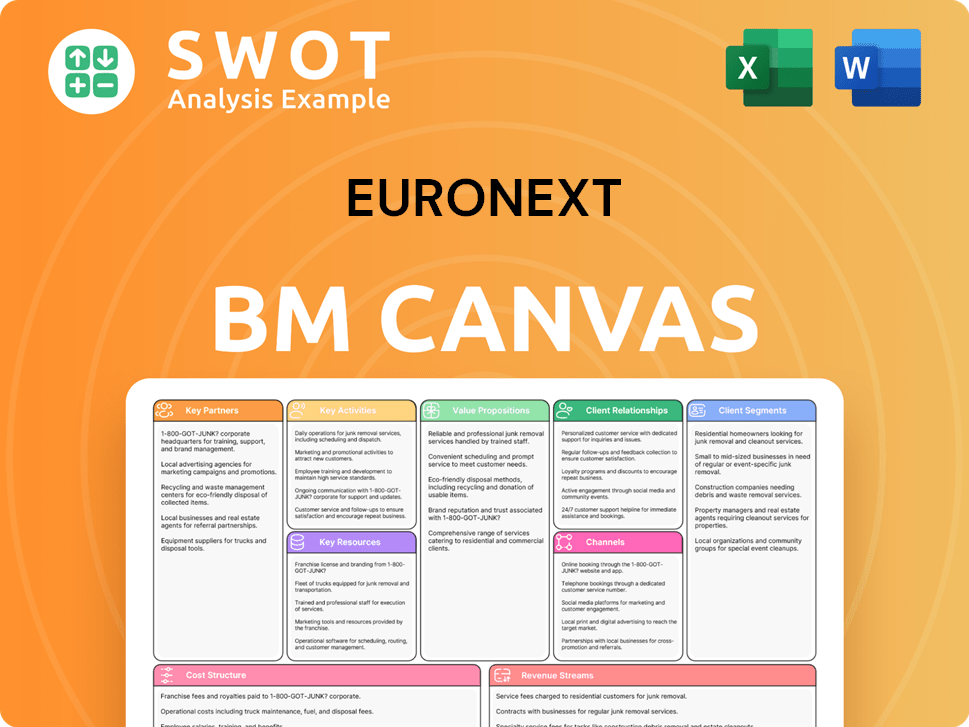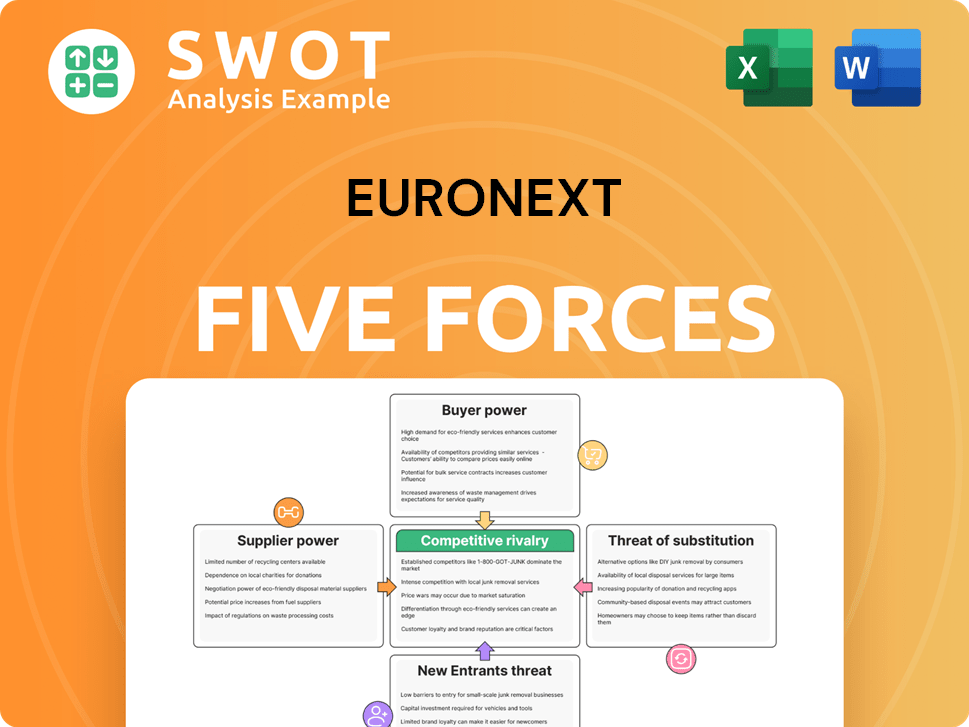Euronext Bundle
How Did Euronext Reshape European Markets?
Delve into the fascinating Euronext SWOT Analysis and uncover the story of Euronext, a financial powerhouse born from the ambition to unify European markets. From its strategic beginnings in 2000, Euronext has evolved into a critical player in the global financial arena. Explore the key moments that shaped this leading pan-European market infrastructure operator.

The Euronext company's journey, beginning with the merger of several stock exchange entities, is a compelling narrative of strategic growth. Understanding the brief history of Euronext, from its initial focus on streamlining trading to its current diversified services, offers crucial insights for investors and business strategists. This evolution has significantly impacted the European financial market, fostering greater efficiency and transparency.
What is the Euronext Founding Story?
The Euronext story began on September 22, 2000. This pivotal date marked the official founding of the company through the merger of the Amsterdam Exchanges (AEX), the Brussels Exchanges (BXS), and the Paris Bourse (SBF). This consolidation was a response to the evolving needs of a globalized financial landscape, where national stock exchanges faced increasing inefficiencies.
The founders recognized the need for a more integrated European capital market. This was essential to better serve both investors and companies seeking capital. Their vision was to create a unified and liquid market that could compete effectively on a global scale. The initial business model focused on creating a single, harmonized trading platform.
The early services included listing and trading functionalities for various securities, along with clearing and settlement services. The goal was to establish a 'single order book' for European blue-chip stocks. This was a revolutionary concept at the time. The broader economic context of European integration, especially the introduction of the Euro, influenced this strategic move. The leadership teams of the merging exchanges, with their extensive experience in market operations and regulation, led this complex integration. They aimed to build a more competitive and attractive market infrastructure for Europe.
Key milestones highlight the evolution of the Euronext company and its impact on European markets.
- 2000: Founding through the merger of Amsterdam, Brussels, and Paris exchanges.
- 2001: Acquisition of the Lisbon Stock Exchange (BVL).
- 2007: Merged with the New York Stock Exchange (NYSE) to form NYSE Euronext.
- 2014: Euronext was listed as a separate entity.
Euronext SWOT Analysis
- Complete SWOT Breakdown
- Fully Customizable
- Editable in Excel & Word
- Professional Formatting
- Investor-Ready Format

What Drove the Early Growth of Euronext?
The early growth and expansion of Euronext, a prominent stock exchange, involved strategic mergers and integration of market functionalities. Following its establishment in 2000, Euronext quickly aimed to broaden its pan-European presence. Key acquisitions and integrations were critical to consolidating the fragmented European markets and establishing Euronext as a major player. The focus was on harmonizing trading rules and technology platforms to create a seamless trading experience for its clients.
A pivotal move in Euronext's expansion was the acquisition of LIFFE (the London International Financial Futures and Options Exchange) in 2002. This significantly boosted Euronext's derivatives trading capabilities and diversified its product offerings. The integration of the Portuguese stock exchange, Bolsa de Valores de Lisboa e Porto (BVLP), in 2002, further solidified its footprint in Southern Europe. These mergers were essential for consolidating the European markets.
Euronext invested heavily in its technology infrastructure, transitioning from separate national systems to a unified and efficient trading engine. This technological advancement was crucial in supporting its growing transaction volumes and expanding client base. The evolution of its trading platform was a key factor in handling increased market activity and maintaining operational efficiency. The development of the trading platform was essential for its growth.
Early customer acquisition strategies focused on attracting both institutional investors and listed companies. This was achieved by offering greater liquidity, lower trading costs, and enhanced visibility across multiple European markets. The financial community generally responded positively, recognizing the benefits of reduced fragmentation and a more integrated market. This strategy helped in attracting new clients.
The consolidation and expansion of Euronext had a significant impact on the financial market, fostering greater efficiency and accessibility. By integrating various stock exchanges, Euronext created a more unified and liquid market for investors. This integration also led to reduced trading costs and improved market transparency. Read more about the Mission, Vision & Core Values of Euronext.
Euronext PESTLE Analysis
- Covers All 6 PESTLE Categories
- No Research Needed – Save Hours of Work
- Built by Experts, Trusted by Consultants
- Instant Download, Ready to Use
- 100% Editable, Fully Customizable

What are the key Milestones in Euronext history?
The Euronext company has achieved several important milestones throughout its history, shaping its role in the financial market. These milestones reflect its growth and strategic adaptations within the European markets.
| Year | Milestone |
|---|---|
| 2000 | Formation of Euronext through the merger of the Amsterdam, Brussels, and Paris stock exchanges. |
| 2001 | Euronext acquires the Lisbon Stock Exchange. |
| 2006 | Euronext completes its initial public offering (IPO), becoming a publicly traded company. |
| 2007 | NYSE Group acquires Euronext, forming NYSE Euronext. |
| 2014 | Intercontinental Exchange (ICE) acquires NYSE Euronext and spins off Euronext as a standalone company. |
| 2021 | Euronext acquires the Borsa Italiana Group from London Stock Exchange Group. |
Euronext has consistently focused on innovation to enhance its services and maintain a competitive edge in the financial market. The development of its proprietary trading platform, Optiq, is a prime example of its commitment to technological advancement.
Optiq is Euronext's high-performance trading platform, designed to handle large trading volumes and provide diverse trading functionalities. It is a key innovation that supports the company's operations across multiple European markets.
Euronext continuously upgrades its technological infrastructure to improve trading efficiency and data services. These upgrades ensure that Euronext remains at the forefront of technological advancements within the stock exchange industry.
Euronext has expanded its services to include a wider range of financial instruments, such as derivatives and fixed income products. This diversification enhances its appeal to a broader range of investors and traders.
Euronext invests in data analytics to provide market insights and enhance trading strategies for its users. These insights help investors make informed decisions and improve market efficiency.
Following acquisitions like Borsa Italiana, Euronext integrates the acquired entities' technology and services to create a unified and efficient platform. This integration streamlines operations and enhances user experience.
Euronext is increasingly focusing on sustainable finance, offering services and products related to ESG (Environmental, Social, and Governance) factors. This includes listings and trading platforms for green bonds and other sustainable financial instruments.
Euronext has faced numerous challenges, including intense competition and regulatory changes, which have required strategic adaptation. The company has demonstrated resilience through mergers and acquisitions, adapting to market dynamics.
Euronext faces intense competition from other global stock exchanges and alternative trading systems. This competition necessitates continuous innovation and strategic adjustments to maintain market share.
Adapting to evolving regulatory landscapes, such as MiFID II, requires significant technological and operational adjustments. Compliance with these regulations is essential for operating within the European markets.
Economic downturns and increased market volatility can impact trading volumes and investor confidence. Euronext must navigate these challenges by providing stable and reliable market infrastructure.
The rapid pace of technological advancements can disrupt traditional market operations. Euronext needs to invest in technology to stay ahead of these disruptions and maintain its competitive edge.
Integrating acquired entities, such as Borsa Italiana, can present operational and cultural challenges. Successful integration is crucial for realizing the benefits of these acquisitions.
Geopolitical events and uncertainties can influence market sentiment and trading activity. Euronext must be prepared to manage risks associated with geopolitical instability.
Euronext Business Model Canvas
- Complete 9-Block Business Model Canvas
- Effortlessly Communicate Your Business Strategy
- Investor-Ready BMC Format
- 100% Editable and Customizable
- Clear and Structured Layout

What is the Timeline of Key Events for Euronext?
The Euronext company has a rich history marked by significant mergers, acquisitions, and strategic expansions. Founded in 2000 through the merger of the Amsterdam, Brussels, and Paris stock exchanges, Euronext quickly grew to become a major player in the European markets. Key milestones include the acquisition of LIFFE in 2002, its IPO in 2006, and the acquisition by NYSE Group in 2007, which formed NYSE Euronext. Following its spin-off from ICE in 2014, Euronext continued its expansion with acquisitions like the Irish Stock Exchange in 2017, Oslo Børs VPS in 2019, and Borsa Italiana Group in 2021. These strategic moves have solidified its position as a leading pan-European market infrastructure.
| Year | Key Event |
|---|---|
| 2000 | Euronext is founded through the merger of the Amsterdam, Brussels, and Paris stock exchanges. |
| 2002 | Acquisition of LIFFE (London International Financial Futures and Options Exchange) and integration of Bolsa de Valores de Lisboa e Porto (BVLP). |
| 2006 | Euronext conducts its Initial Public Offering (IPO). |
| 2007 | NYSE Group acquires Euronext, forming NYSE Euronext, creating the first transatlantic exchange. |
| 2014 | Intercontinental Exchange (ICE) acquires NYSE Euronext and subsequently spins off Euronext as an independent company. |
| 2017 | Acquisition of the Irish Stock Exchange (ISE). |
| 2019 | Acquisition of Oslo Børs VPS, expanding its presence in the Nordics. |
| 2021 | Completion of the acquisition of Borsa Italiana Group from London Stock Exchange Group for €4.4 billion, significantly enhancing its fixed income and clearing capabilities. |
| 2023 | Euronext reports Q4 2023 revenue of €372.2 million, up 7.2% from Q4 2022, and full-year 2023 revenue of €1.474 billion, up 3.9% from 2022. |
| 2024 | Euronext announces its 'Growth for Impact 2024' strategic plan, focusing on sustainable growth and diversification of revenue streams. |
In 2025, Euronext continues to execute its 'Growth for Impact' strategic plan. This involves the integration of recent acquisitions, particularly Borsa Italiana, and expanding technology and managed services. The company aims to strengthen its position as a leading pan-European market infrastructure.
Euronext reported Q1 2024 revenue of €395.7 million, a 6.2% increase compared to Q1 2023. The company's focus remains on organic growth and potential mergers and acquisitions to enhance its product offerings and geographical reach, driving further financial growth.
Analyst predictions suggest continued growth in Euronext's post-trade services and data solutions. This growth is driven by the increasing demand for market transparency and efficiency, reflecting the evolving needs of the financial market.
Euronext's future outlook depends on its ability to innovate in response to changing market demands. Leveraging its expanded ecosystem and commitment to fostering efficient capital markets across Europe will be crucial for continued success. This aligns with the company's founding vision of a unified European financial landscape.
Euronext Porter's Five Forces Analysis
- Covers All 5 Competitive Forces in Detail
- Structured for Consultants, Students, and Founders
- 100% Editable in Microsoft Word & Excel
- Instant Digital Download – Use Immediately
- Compatible with Mac & PC – Fully Unlocked

Related Blogs
- What is Competitive Landscape of Euronext Company?
- What is Growth Strategy and Future Prospects of Euronext Company?
- How Does Euronext Company Work?
- What is Sales and Marketing Strategy of Euronext Company?
- What is Brief History of Euronext Company?
- Who Owns Euronext Company?
- What is Customer Demographics and Target Market of Euronext Company?
Disclaimer
All information, articles, and product details provided on this website are for general informational and educational purposes only. We do not claim any ownership over, nor do we intend to infringe upon, any trademarks, copyrights, logos, brand names, or other intellectual property mentioned or depicted on this site. Such intellectual property remains the property of its respective owners, and any references here are made solely for identification or informational purposes, without implying any affiliation, endorsement, or partnership.
We make no representations or warranties, express or implied, regarding the accuracy, completeness, or suitability of any content or products presented. Nothing on this website should be construed as legal, tax, investment, financial, medical, or other professional advice. In addition, no part of this site—including articles or product references—constitutes a solicitation, recommendation, endorsement, advertisement, or offer to buy or sell any securities, franchises, or other financial instruments, particularly in jurisdictions where such activity would be unlawful.
All content is of a general nature and may not address the specific circumstances of any individual or entity. It is not a substitute for professional advice or services. Any actions you take based on the information provided here are strictly at your own risk. You accept full responsibility for any decisions or outcomes arising from your use of this website and agree to release us from any liability in connection with your use of, or reliance upon, the content or products found herein.